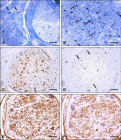About Potiguar University
Potiguar University
Articles by Potiguar University
Dry eye syndrome: Therapeutic challenges and future trends
Published on: 12th December, 2019
OCLC Number/Unique Identifier: 8500737592
Introduction: Intense Pulsed Light (IPL) is the therapeutic tool implemented in the treatment of dry eye, characterized by the emission of waves of 500-1200nm in the region of the upper and lower eyelids. Dry eye is a recurring complaint in ophthalmology offices and has an impact on the patient’s quality of life. It results from dysfunction of the meibomian glands, duct obstruction, and quantitative and qualitative changes in glandular secretion. It is manifested by dryness and irritation, foreign body sensation, burning, tearing, and eye fatigue. The available treatments are short term palliative with unsatisfactory results.
Tamsulosin and Dementia in old age: Is there any relationship?
Published on: 1st October, 2019
OCLC Number/Unique Identifier: 8280929913
Tamsulosin is used to treat Benign Prostatic Hyperplasia (BPH), prescribed annually to about 12.6 million patients worldwide. It is an alpha-adrenergic antagonist that reduces the tone of the prostate smooth muscle involved in the pathophysiology of BPH. By acting on alpha 1A receptors, predominant in the prostate, tamsulosin also acts on receptors present in the brain. This study consisted of a literature review aimed at disseminating scientific knowledge about the relationship between the use of tamsulosin and the onset of dementia. PubMed, Scopus, Scielo, Embase, and Web of Science studies involving dementia in patients using tamsulosin in the last five years were selected. The review showed a risk correlation and a higher incidence of dementia in treated patients. The risk ratio, when compared to other medicines, approached 1.20. In conclusion, it was identified the need for clinical trials with higher sampling power to increase relational significance due to the high prevalence of BPH and the extensive use of tamsulosin in elderly patients with the disease.
Association of Cytokine Gene Polymorphisms with Inflammatory Responses and Sepsis Outcomes in Surgical and Trauma Patients
Published on: 19th February, 2024
Sepsis, a life-threatening condition triggered by infection, poses a significant healthcare challenge with high mortality rates. The interplay between genetics and the immune response in sepsis, particularly in surgical and trauma patients, is complex and critical. Genetic polymorphisms, particularly in cytokine genes like TNF-α, IL-6, and IL-8, have been extensively studied for their influence on sepsis susceptibility, severity, and outcomes. Polymorphisms can alter gene expression and cytokine production, leading to variations in immune responses. Studies have also explored polymorphisms concerning sepsis in genes encoding CD86, TLR4, and SIRT6. This review highlights the association between genetic polymorphisms and inflammatory responses, focusing on their impact on sepsis outcomes in surgical and trauma patients. Genetic variations play a significant role in sepsis risk, severity, and prognosis, with potential implications for personalized therapeutic strategies. Biomarkers such as cytokine gene polymorphisms may aid in predicting sepsis risk and guiding treatment decisions. Complementary therapies like acupuncture and novel biomarkers like microvesicles carrying mitochondrial content provide additional avenues for personalized sepsis management. Furthermore, multiomics approaches offer promise in predicting postoperative outcomes in surgical patients. Understanding the genetic basis of sepsis is essential for improving prevention, diagnosis, and treatment, ultimately leading to better clinical outcomes. Combining genomics, bioinformatics, and clinical expertise, precision medicine can revolutionize sepsis management by tailoring interventions to individual genetic profiles, thus enhancing patient care and outcomes.
COVID-19, Long COVID, and Gastrointestinal Neoplasms: Exploring the Impact of Gut Microbiota and Oncogenic Interactions
Published on: 4th September, 2024
Background: The impact of COVID-19 and long-term COVID-19 on gastrointestinal neoplasms remains underexplored. The current review investigates the potential link between these conditions and the role of gut microbiota in mediating oncogenic processes. Dysbiosis, characterized by alterations in gut microbial composition, may exacerbate inflammation and immune dysregulation, contributing to cancer development.Methods: A comprehensive literature review was conducted using databases including PubMed, Scopus, Embase, SciELO, and Web of Science. Inclusion criteria encompassed studies published between 2020 and 2024 that explored the intersection of COVID-19, long-term COVID-19, and gastrointestinal cancers. The articles were critically appraised for quality and relevance, and data were synthesized to elucidate common mechanisms and outcomes.Results: The review identifies several mechanisms by which gut microbiota may influence cancer risk in COVID-19 patients. Persistent inflammation, oxidative stress, and immune dysfunction observed in Long COVID were associated with dysbiosis. Specific microbial metabolites, such as secondary bile and short-chain fatty acids, were implicated in promoting tumorigenesis. Comparative analysis of studies suggests that SARS-CoV-2-induced dysbiosis may heighten susceptibility to gastrointestinal cancers, particularly in patients with prolonged post-infection symptoms.Conclusion: The findings underscore the need for further research to clarify the role of gut microbiota in cancer development among COVID-19 patients. These mechanisms could inform preventative strategies and therapeutic interventions, particularly for those experiencing COVID. The review highlights gaps in current knowledge and advocates for longitudinal studies to assess the long-term effects of COVID-19 on gastrointestinal health.

HSPI: We're glad you're here. Please click "create a new Query" if you are a new visitor to our website and need further information from us.
If you are already a member of our network and need to keep track of any developments regarding a question you have already submitted, click "take me to my Query."


















































































































































